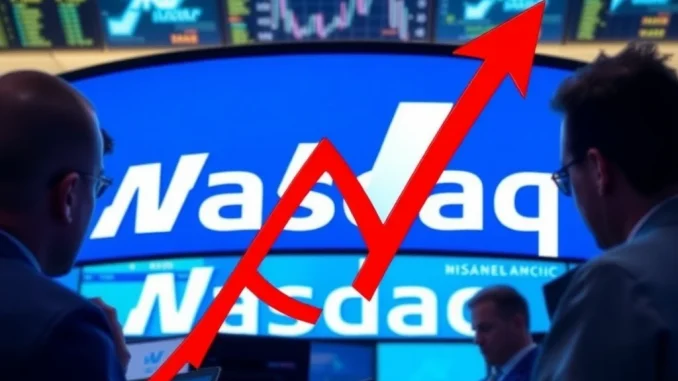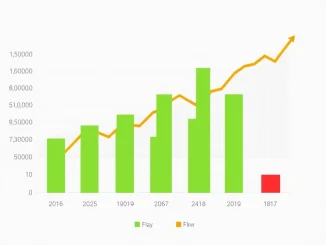
Just moments after the opening bell rang, Wall Street witnessed a dramatic downturn as the Nasdaq Composite experienced a shocking Nasdaq drop, plummeting 3% in the early hours of trading. This sudden jolt of market volatility has sent ripples of concern across the financial landscape, leaving investors and analysts alike scrambling to understand the underlying causes and potential repercussions. What’s behind this unsettling market movement, and what does it signal for the broader economy and your investment portfolio?
Decoding the Dramatic Nasdaq Drop: What’s Triggering the Investor Panic?
The Nasdaq, renowned for its heavy concentration of tech stocks, is often considered a key indicator of growth sectors and innovation. A significant Nasdaq drop like this immediately sparks questions and concerns. Several factors could be converging to fuel this early market turmoil and trigger investor panic. Let’s break down some of the potential catalysts:
- Inflationary Pressures Remain Persistent: Despite efforts to curb inflation, recent economic data may be suggesting that inflationary pressures are proving more stubborn than anticipated. This could lead to expectations of more aggressive interest rate hikes by central banks, dampening investor sentiment.
- Rising Bond Yields: As inflation concerns linger, bond yields have been climbing. Higher yields make bonds more attractive compared to stocks, potentially leading investors to shift assets away from equities, contributing to the stock market decline.
- Geopolitical Uncertainties: Global events and geopolitical tensions always add an element of unpredictability to the markets. Any escalation in international conflicts or trade disputes can quickly translate into market volatility and investor anxiety.
- Corporate Earnings Outlook: While earnings season is underway, the forward-looking guidance from companies might be painting a less optimistic picture than previously hoped. Concerns about slowing economic growth could be impacting corporate profitability forecasts, leading to downward pressure on stock prices.
- Profit Taking and Market Correction: After periods of market gains, profit-taking is a natural phenomenon. Investors may be choosing to lock in profits, and this could be exacerbating the downward pressure, potentially leading to a broader stock market correction.

Navigating the Turbulent Waters: Understanding Market Volatility and Economic Uncertainty
Periods of market volatility can be unsettling, but it’s crucial to remember that market fluctuations are a normal part of the economic cycle. Understanding the current landscape of economic uncertainty is key to making informed decisions. Here’s what you should consider:
| Aspect | Implication |
|---|---|
| Increased Market Swings | Expect larger daily price fluctuations in the stock market. This can present both risks and opportunities. |
| Potential for Correction | A significant Nasdaq drop could signal the beginning of a broader market correction, where prices adjust downwards after a period of growth. |
| Shift in Investment Strategy | Investors might reconsider their asset allocation, potentially moving towards more defensive sectors or hedging strategies. |
| Long-Term Perspective Crucial | Focus on long-term investment goals rather than reacting impulsively to short-term market movements. |
Investor Panic or Prudent Reaction? Analyzing the Market Sentiment
The speed and magnitude of the Nasdaq drop have undoubtedly triggered a degree of investor panic. Fear can be a powerful driver in the markets, often leading to emotional decision-making. However, it’s important to differentiate between panic-driven selling and a more rational market adjustment.
Is this investor panic justified, or is it an overreaction? Here’s a balanced perspective:
- Panic Selling: When fear takes over, investors may rush to sell assets indiscriminately, regardless of their underlying value. This can create a self-fulfilling prophecy, driving prices down further.
- Rational Adjustment: Alternatively, the market drop could be a rational response to evolving economic realities. Investors might be reassessing valuations in light of higher interest rates and a potentially slower growth environment.
- Opportunity for Long-Term Investors: For investors with a long-term horizon, periods of market downturn can present opportunities to buy quality assets at discounted prices.
Actionable Insights: Navigating Economic Uncertainty and Market Volatility
So, what can investors do amidst this economic uncertainty and market volatility? Here are some actionable insights:
- Stay Calm and Avoid Impulsive Decisions: Resist the urge to make rash decisions based on fear. Market downturns are often temporary.
- Review Your Portfolio: Assess your portfolio’s risk exposure and diversification. Ensure it aligns with your long-term financial goals and risk tolerance.
- Consider Dollar-Cost Averaging: For long-term investing, consider dollar-cost averaging – investing a fixed amount of money at regular intervals, regardless of market fluctuations.
- Seek Professional Advice: If you are unsure about how to navigate the current market environment, consult with a qualified financial advisor.
- Stay Informed, But Avoid Overconsumption of News: Keep abreast of market developments, but avoid getting overwhelmed by constant news cycles, which can amplify anxiety.
Conclusion: Weathering the Storm of Market Volatility and Economic Uncertainty
The Nasdaq drop serves as a stark reminder of the inherent market volatility and economic uncertainty that are part and parcel of the financial world. While a 3% plunge in early trading is undoubtedly concerning, it’s essential to maintain a long-term perspective and avoid knee-jerk reactions driven by investor panic. By understanding the potential drivers behind the market movement, staying informed, and making prudent, well-considered decisions, investors can navigate these turbulent waters and position themselves for long-term financial success. Remember, market downturns, while unsettling, can also present opportunities for those who remain patient and strategic.



